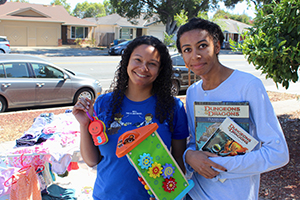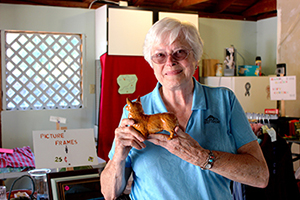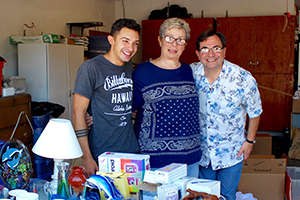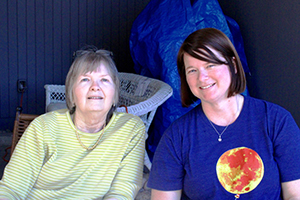ONE MAN'S TREASURE: Cupertino's city-wide Garage Sale
Cupertino holds its 20th annual city-wide garage sale for residents
Click HereThe conventional American neighborhood seems to be disappearing — at least in Cupertino. Residents don’t crowd over lemonade stands, block parties aren’t held every week and neighbors don’t exactly bake each other apple pies. The wave of immigrants in Cupertino has replaced a lot of the traditional American culture. Yet, amidst all the change, garage sales, an old American tradition, have not disappeared from our community.
Cupertino has been holding its annual city-wide Garage Sale since 1996. Originally, the event was created to prevent useful items from going to the landfill, but now, the Garage Sale weekend instills a sense of community between residents.
In this interactive package, El Estoque tours the streets for Cupertino’s 20th annual city-wide Garage Sale and explores how garage sales have had an impact on our community, from reducing waste to bringing residents closer together to identifying the people behind the garage sale and the stories behind their objects.
by Hannan Waliullah and Ilena Peng with additional reporting by Aanchal Garg
With the construction of Apple's new headquarters and opening of Main Street, Cupertino is starting to embrace a big city vibe. But throughout all the change, one small town custom persisted — garage sales.
Listen to the podcast below to learn more about the garage sales of cupertino.
by Aanchal Garg with additional reporting by Hannan Waliullah
Part of the appeal of the event is getting to know your neighbors and other residents in the city. To get to know the people behind the garage sales and what they sold, click on each of the tabs below.

Dorrie Downas: [We've lived here] about 45 years. In the beginning, there used to be tons of people both days. Now, it's not as many.
You can't hold on to everything. I used to have [these plates] in the hallway for 30 years. My sister Helen gave them to me, but she died.
Dorrie Downas clutches antique plates given to her by her late sister Helen. Downas says that even thought the plates have sentimental value to her, she cannot keep everything. Photo by Aanchal Garg.

Jennifer Greene: This is my first year [hosting a garage sale]. I decided a week or two ago to just do this. I have too much stuff in the house, and I thought this was a cool way to be involved and get rid of stuff at the same time.
Autumn Greene: I remember we got the entire cul-de-sac to help us buy [the Dungeons and Dragons books], and we all just read them together. I kind of wanted to make sure that I [gave] it to someone who would actually enjoy them. That's why I figured the garage sale might be a good way to find people who really would like to read any of the Dungeons and Dragons books.
Jennifer Greene (left) holds hand-me-down baby toys from her garage sale while her daughter Autumn Greene holds her collection of Dungeons and Dragons fourth edition books. This is the first time that the Greene family is holding a garage sale in Cupertino. Photo by Aanchal Garg

Georgyne Purcell: This is the third time we've done the Cupertino garage sale. I thought it was time to get rid of some of my corgi figurines. I used to raise corgis and both my boys trained the corgis. But they're gone now. I've been to England about seven times and everytime I go over, I buy one or two more. It's like a tradition.
Georgyne Purcell holds one of her corgi figurines that she is selling in her garage sale. Purcell got each figurine from her various trips to England. Photo by Aanchal Garg.

El Estoque: What do you normally sell at your garage sale?
Christopher Laporta: Socks.
Moreen Cassidy: [Christopher's aunt], Carol, is a purchaser. She just keeps pulling them out. This is the only way we get rid of Carol's stuff.
Paul Bommarito: [We have] probably 500 pairs of socks.
CL: We had dwindled them down to about one towel [last year], and this year [Carol] comes out with two more giant bags [of socks].
MC: She has more socks than she has feet, I'll tell you that.
Christopher Laporta (left), Moreen Cassidy (middle) and Paul Bommarito (right) are known for the endless amount of socks laid out on towels in front of their garage. Laporta's aunt, Carol, buys socks annually, so Laporta and his family have to sell them every year. Photo by Aanchal Garg.

Maggie Burleson: I've been [in Cupertino for] two years and she’s been here less than a year.
Carol Romanski: I like watching the people and seeing them be interested in your stuff. I know it's an old lady thing, but I've talked about my past more because people want to know where [our items] came from. It feels good to get it out and get it to somebody who can use it for not much money.
MB: I find that’s one of the ways to encourage my kids to get rid of their toys. They can get the money for it, and they can use it to buy something new. It kind of helps keep our toy problem down and also teaches them how to spend some money.
Christopher Laporta (left), Moreen Cassidy (middle) and Paul Bommarito (right) are known for the endless amount of socks laid out on towels in front of their garage. Laporta's aunt, Carol, buys socks annually, so Laporta and his family have to sell them every year. Photo by Aanchal Garg.
by Becca Zheng
It takes a massive load of time and effort to physically gather your past unwanted items and put them on tables to sell to strangers. Items such as furniture, toys, books, magazines etc. are laid out in front of the owner’s house ready to be purchased with varying prices ranging from 50 cents to $2. Click below to watch local citizens talk about the decision behind hosting a garage sale, along with the benefits in doing so.
by Bhargava Matta and Devika Watave
A garage sale can include anything and everything. And behind just about any garage sale item – from a knitted quilt that’s been passed down to a dress that no longer fits to a baseball glove that never got used – is a unique story. Garage sales are places where you will find normal items with not only cheap prices but also interesting pasts.
Hover over the pictures below to find out the stories behind eight featured items.
Photos by Bhargava Matta
Click through the photo gallery for more pictures from the garage sale
Photos by Hannan Waliullah, Devika Watave and Aanchal Garg